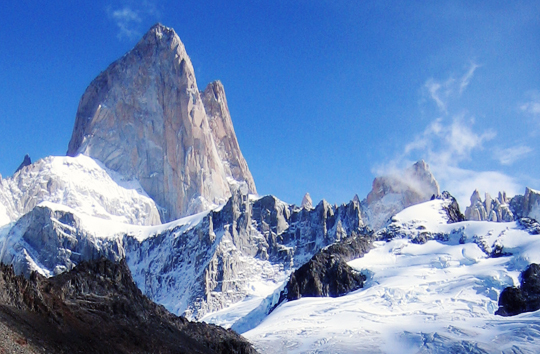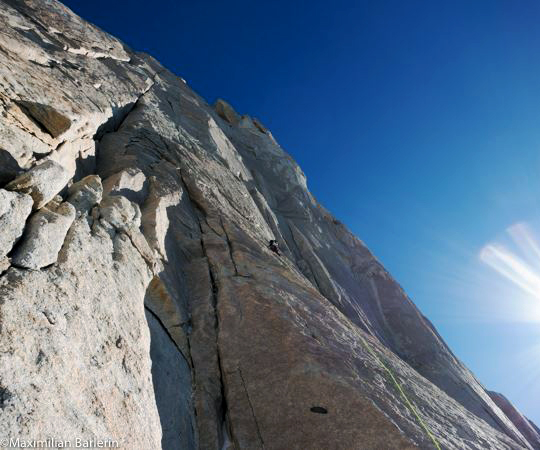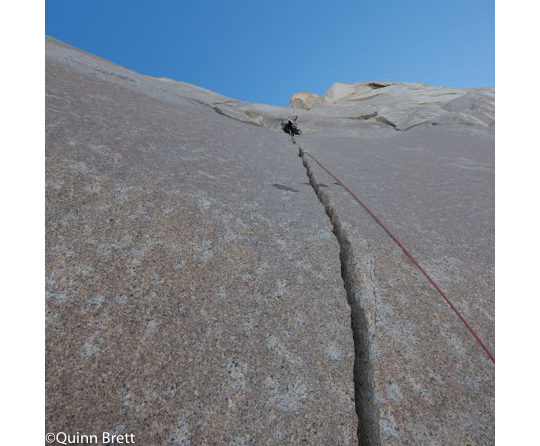
[Photo] Lion Hirth/Wiki Commons
After ogling over Patagonia photos at home in Colorado, on the plane ride down to South America, and even from a vantage point overlooking the mountain, Max Barlerin did his best to convince me that we should climb a new route up Fitz Roy. During the start of our trip, while climbing in glorious weather, we started a cost-benefit analysis as a joke to help us decide on our next adventure. As we sat drinking Malbec in El Chalten with Mike Lukens, Barlerin’s vision for a line up the south side of Fitz Roy (3405m) edged to the top of the next-climb list.

[Photo] Max Barlerin
Southern Patagonia is famous for its turbulent and heinous weather. While this is only my third season in Patagonia, every year the mountain conditions have varied from great to desperate. Warm weather spells and melting snow this year have made crack climbing on the south faces more feasible than previously since they were free of ice. So with great weather, we were excited and made a plan to attempt a new route on Fitz Roy’s South Face.
The approach across Glacier Peidras Blancas Superior to Fitz Roy is complicated and dangerous, with several large crevasses past Paso Guillaumet. The glacier crossing was difficult. On Day 1, Wednesday, January 20, we delicately crossed two narrow snow bridges, and then climbed to a bivouac site below the intimidating 4,000-foot-high East Face, which towered above our heads.
We simul-soloed up a 60-degree snow slope left of The Brecha (The Gap). Above we rested, ate and worked on our tans while watching the light change as it moved across the monolithic South Face. The light gradually revealed a line that went directly up the wall. We could see the route except for a giant roof and dihedral at the top. We couldn’t believe that a line so beautiful and clean was still untouched.

[Photo] Quinn Brett
On Thursday morning, we woke at 2:30 a.m. and started the approach a couple hours later. Near the base of the South Face, we waited for more light, then climbed snow to the base of the wall. Starting at 6:30 a.m, we jammed a beautiful finger crack to reach a short offwidth section. Then we began climbing the first of many splitter cracks. The fantastic jamming up a thousand feet of splitters offered everything from finger jams and ring-locks to fist jams and occasional wide sections. We climbed thirteen pitches, mostly on 5.10 and 5.11 cracks, on solid golden rock for twelve hours to the top of a headwall.
We simulclimbed the last section to the summit of Fitz Roy. That night, beneath a pastel-colored sunset, we bivouacked on the summit, spooning beneath the summit block to fend off the cold. The next morning dawned clear, with the descent cruxes still below us.
We rappelled down the Franco-Argentine Route, which is a time-consuming, rope-snagging mess. Our ropes got stuck three times, and each of us took a turn to retrieve them. At one point, I climbed sideways through a waterfall to retrieve the rope that hung up. It was challenging to free the stuck lines but our morale was high. After reaching snow at La Silla in the early afternoon, we brewed up, and then made the final rappels down to The Brecha followed by a slushy hike across Piedras Blancas glacier. Our final bivouac was on the shore of electric-blue Laguna de los Tres below the glacier.
We named our new line The Colorado Route (5.11c, 500m). It’s an amazing climb. I’m trying to convince Max to go climb it again.
FA: Max Barlerin, Quinn Brett, and Mike Lukens
Sources: Quinn Brett, pataclimb.com
Article updated on February 12, 2016 at 2:51 p.m. EST.